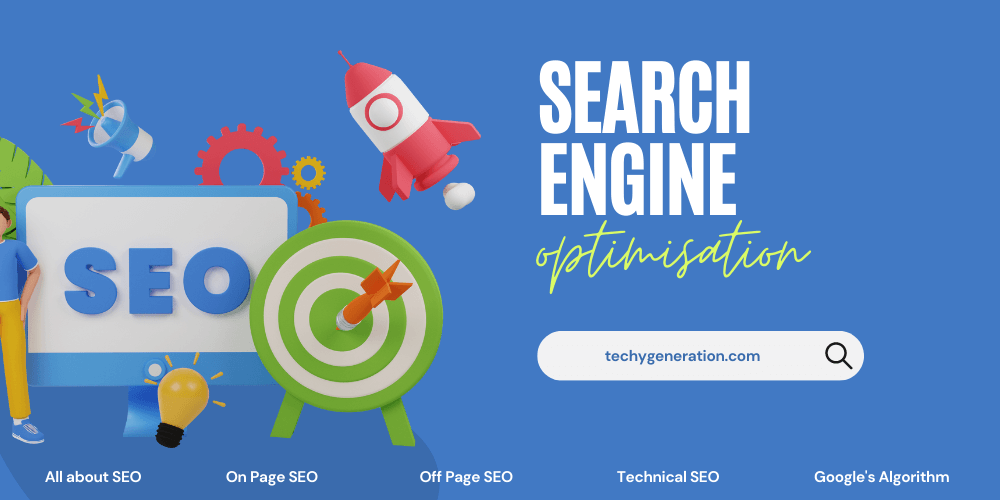In today’s digital age, having a strong online presence is crucial for businesses and individuals alike. Search engines play a vital role in connecting users with relevant information, products, and services. Search Engine Optimization (SEO) is the practice of optimizing websites to improve their visibility and rankings on search engine results pages (SERPs).
This article aims to provide a comprehensive overview of SEO basics, using simple language to make it easy for beginners to understand and implement.
Table of Contents
What is SEO?
SEO stands for “Search Engine Optimization”. It refers to the process of improving a website’s visibility and ranking on search engines like Google. The goal of SEO is to attract more organic (non-paid) traffic to a website by optimizing various aspects of the site.
Why is SEO important?
SEO is important because it helps your website appear higher in search engine results pages (SERPs). When your website ranks higher, it has a better chance of being seen by people searching for relevant information or products. Increased visibility can lead to more organic traffic, potential customers, and business opportunities.
On-Page SEO: Dominate Search Engine Results!
On-page SEO focuses on optimizing the content and HTML source code of individual web pages. This includes elements like keyword research, optimizing meta tags (titles and descriptions), using proper heading tags, improving page load speed, creating high-quality and relevant content, and optimizing images. On-page SEO helps search engines understand and rank your web pages better.
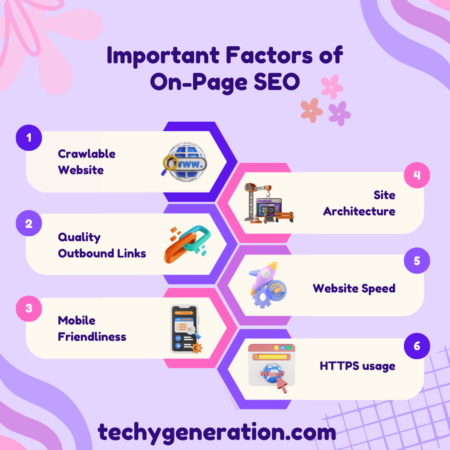
Here are some key elements of on-page SEO:
- Content optimization: This involves creating high-quality, relevant, and engaging content that includes targeted keywords and phrases in the right places.
- Meta tags optimization: This includes optimizing page titles, meta descriptions, and header tags to provide context and relevance to search engines and users.
- URL structure optimization: This involves creating clean and structured URLs that are easy for search engines to crawl and understand.
- Internal linking: This includes linking to other relevant pages on your website to improve navigation and enhance the user experience.
- Image optimization: This involves optimizing image file names, alt tags, and captions to provide context to search engines and improve the accessibility and user experience.
- Site speed optimization: This includes optimizing page load times, compressing images, and minifying code to improve site speed, user experience, and search engine rankings.
On-page SEO is an essential aspect of any SEO strategy, as it helps search engines understand what a web page is about and how relevant it is to users’ search queries. By optimizing on-page elements, website owners can improve their rankings in search engine results pages and attract more targeted traffic to their site.
Off-Page SEO: Expand Your Digital Footprint!
Off-page SEO refers to activities done outside of your website to improve its visibility and authority. It involves building high-quality backlinks from other reputable websites, social media marketing, influencer outreach, guest blogging, and online reputation management. Off-page SEO signals help search engines assess the credibility and popularity of your website.
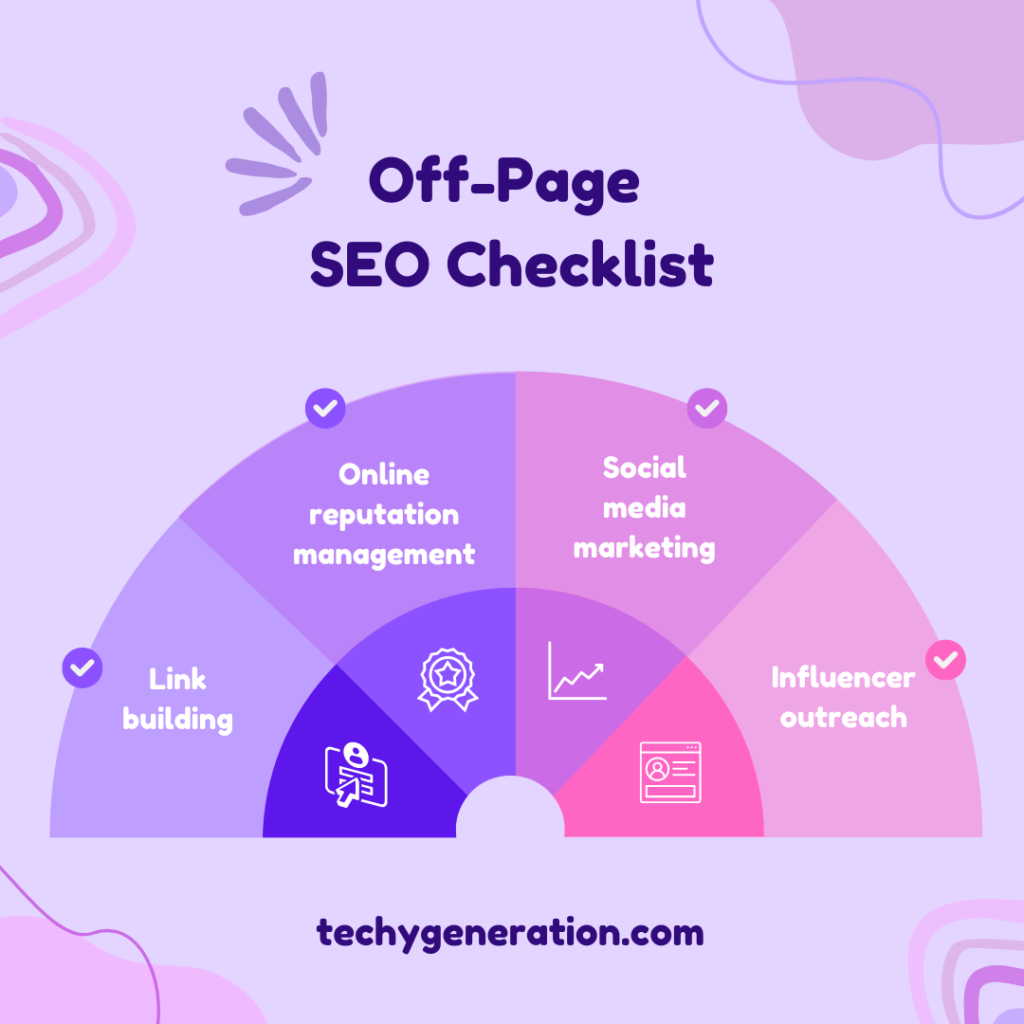
Here are some key elements of off-page SEO:
- Link building: This involves acquiring backlinks from other websites to improve your website’s authority and credibility in the eyes of search engines. Backlinks from high-quality and relevant websites can significantly improve your search engine rankings.
- Social media marketing: This includes promoting your website and its content on various social media platforms to improve your brand visibility, attract more followers and drive more referral traffic.
- Online reputation management: This involves monitoring and managing your brand’s online reputation and addressing negative feedback or reviews to maintain a positive image.
- Influencer outreach: This includes building relationships with influencers and bloggers in your industry and getting them to promote your website and content to their followers.
- Content marketing: This involves creating high-quality, informative, and engaging content that can attract links and social shares from other websites.
Off-page SEO is essential for building your website’s authority and credibility, attracting more backlinks and referral traffic, and improving your search engine rankings. By implementing effective off-page SEO strategies, you can increase your website’s visibility, drive more targeted traffic, and ultimately, grow your business.
Technical SEO: Enhance Your Website’s Performance!
Technical SEO focuses on optimizing the technical aspects of a website to improve its search engine visibility. It includes tasks like ensuring proper website indexing, optimizing website structure and navigation, improving site speed and performance, implementing schema markup, fixing broken links, and making the website mobile-friendly. Technical SEO helps search engines crawl, understand, and index your site effectively.
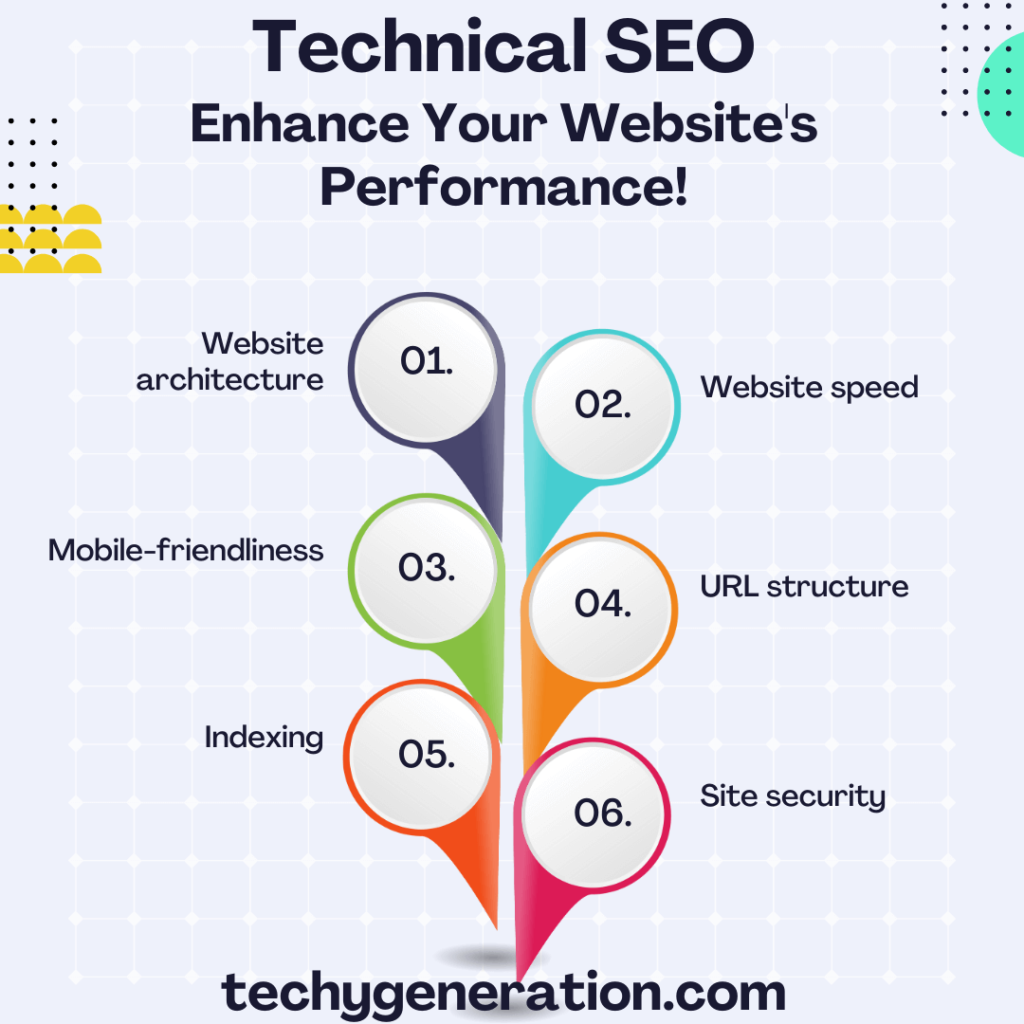
Here are some key elements of technical SEO:
- Website architecture: This includes optimizing the website’s structure and navigation to improve its crawlability and user experience. It involves creating a clear hierarchy of pages and ensuring that each page is easily accessible from the homepage.
- WebSite speed: This involves optimizing the website’s load time by compressing images, minifying code, and leveraging browser caching. Faster loading websites tend to rank higher in search engine results pages and provide a better user experience.
- Mobile-friendliness: This includes optimizing the website for mobile devices by using responsive design, ensuring that the website is easy to navigate on small screens, and loads quickly on mobile devices.
- URL structure: This involves creating clean and structured URLs that are easy for search engines to crawl and understand.
- Schema markup: This includes using schema markup to provide search engines with additional information about the website’s content, such as reviews, ratings, and product information.
- Site security: This involves implementing SSL certificates to encrypt website traffic, preventing unauthorized access and hacking attempts.
- Indexing: Ensuring that search engine crawlers can easily access and understand your website’s content. This involves creating a clear site structure, using proper HTML tags, and providing a Robot.txt and Sitemap for search engines to follow. Make sure your website is connected with Google Analytics and Webmaster Tool to track and analyze data.
Technical SEO is essential for ensuring that your website is optimized for search engine crawlers, providing a better user experience, and improving your website’s visibility and rankings in search engine results pages. By implementing effective technical SEO strategies, you can improve your website’s crawlability, indexability, and performance, and ultimately drive more traffic and revenue for your business.
Difference between White Hat SEO, Black Hat SEO and Grey Hat SEO

White Hat SEO:
Refers to ethical and legitimate SEO practices that abide by search engine guidelines. It involves creating high-quality content, using relevant keywords, optimizing meta tags, building natural backlinks, and providing a good user experience.
Here are some key elements of white hat SEO:
- Quality content: This involves creating high-quality and relevant content that provides value to the audience and satisfies their search intent. Content should be original, informative, and engaging, and should be optimized with relevant keywords and meta tags.
- Proper keyword research: This involves conducting keyword research to identify relevant keywords and phrases that your target audience is searching for, and using them naturally in your content.
- On-page optimization: This includes optimizing the website’s structure, meta tags, headings, and other on-page elements to make it easy for search engines to understand the content.
- Link building: This involves acquiring backlinks from other high-quality and relevant websites through natural means, such as creating quality content and promoting it through outreach and social media.
- Social media marketing: This includes using social media platforms to promote your website and its content and engage with your audience.
- Mobile optimization: This involves optimizing the website for mobile devices, including using responsive design and ensuring that the website loads quickly on mobile devices.
White hat SEO practices are essential for building a sustainable and long-term online presence. By following ethical and legitimate SEO practices, you can improve your website’s rankings in search engine results pages, attract more organic traffic, and ultimately build a loyal audience and grow your business.
Black Hat SEO:
Involves using unethical and manipulative techniques to improve search engine rankings. This can include keyword stuffing, hidden text, cloaking, and buying links. Search engines penalize websites that engage in black hat practices.
Here are some examples of black hat SEO techniques:
- Keyword stuffing: This involves overusing keywords or phrases in content or meta tags in order to manipulate search engine rankings.
- Hidden text or links: This involves hiding text or links within a webpage to manipulate search engine rankings.
- Cloaking: This involves showing different content to users and search engines to deceive search engines and improve rankings.
- Link farming: This involves creating a network of low-quality websites and linking them together to manipulate search engine rankings.
- Buying links: This involves purchasing links from other websites in order to manipulate search engine rankings.
- Article spinning: This involves creating low-quality, spun content in order to manipulate search engine rankings.
Black hat SEO practices can result in penalties from search engines, including lower rankings, de-indexing, or even permanent bans. These practices also provide a poor user experience, which can harm the website’s reputation and credibility. It’s important to follow ethical and legitimate SEO practices, such as white hat SEO, to improve your website’s rankings in a sustainable and long-term manner, and to provide the best possible user experience and value to your audience.
Grey Hat SEO:
Falls between white hat and black hat techniques. It involves practices that may not be explicitly against search engine guidelines but can still be considered questionable or manipulative. Examples include purchasing expired domains for backlinks or using automated content generation tools. Grey hat techniques carry some level of risk as search engines may penalize them in the future.
Some examples of grey hat SEO practices include:
- Link exchange: This involves exchanging links with other websites to improve search engine rankings. While this is not inherently black hat, it can be seen as an attempt to manipulate search engine rankings.
- Buying expired domains: This involves purchasing an expired domain with a good backlink profile and redirecting the traffic to your website. While this is not explicitly prohibited by search engines, it can be seen as a manipulation of search engine rankings.
- Guest blogging: This involves writing guest posts for other websites in order to acquire backlinks. While this can be a legitimate white hat SEO practice, it can also be seen as a grey hat SEO practice if the guest posts are of low quality or if the links are not relevant.
- Keyword cannibalization: This involves optimizing multiple pages on a website for the same keyword, which can lead to confusion for both search engines and users.
- Duplicate content: This involves copying content from other websites or creating duplicate content on a website. While this is not explicitly black hat, it can be seen as an attempt to manipulate search engine rankings.
Grey hat SEO practices should be used with caution, as they can lead to penalties from search engines and harm a website’s reputation and credibility. It’s important to prioritize ethical and legitimate SEO practices, such as white hat SEO, in order to build a sustainable and long-term online presence.
Major Google Algorithms Update
Google uses various algorithms to determine the ranking of web pages in search results. Some of the important algorithms till 2022 include:
- Caffeine Index Update: Introduced in 2010. The new indexing method was created to speed up the search results for users, and also aid publishers in getting their content more quickly.
- Google Panda: Introduced in 2011, it focused on penalizing low-quality and thin content websites.
- Google Penguin: Launched in 2012, it targeted websites with unnatural or spammy backlink profiles.
- Google Hummingbird: Released in 2013, it aimed to provide more relevant search results by understanding user intent better.
- Google Pigeon: Rolled out in 2014, it focused on improving local search results and the connection between local businesses and search queries.
- Google RankBrain: Introduced in 2015, it is an AI-based algorithm that helps Google understand and interpret search queries better.
- Possum: Introduced in 2016, Possum improved local search results. Before this update, businesses located just outside of the city limits struggled to rank well for keywords associated with their location. This update also increased the importance of the physical location and variations in local terms.
- Fred: Introduced in 2017, When this update is launched, This Algorithm penalizes websites that use aggressive ad placement, large pop-ups, Aggressive affiliate linking, and Deceptive ads (ads that appear as content).
- Mobile Page Speed Update: Introduced in 2018, This update included new ranking signals that favor pages with page speed. This update was part of Google’s overall “speed up internet” initiative as well as Google’s “mobile first” initiative.
- Google BERT: Released in 2019, it improved the understanding of natural language and context in search queries.
- Google Core Updates: These updates, released periodically, bring broad changes to Google’s algorithms and can impact website rankings significantly.
Supercharge Your SEO Efforts: Must-Have Tools for Success!
There are several SEO tools available to help with keyword research, on-page optimization, backlink analysis, competitor analysis, and performance tracking.
Some popular SEO tools include:
- Yoast SEO: Yoast SEO is a WordPress plugin that helps you optimize your content for search engines. It provides real-time analysis of your content, including meta tags, readability, and keyword density.
- SEMrush: SEMrush is an all-in-one SEO tool that includes a range of features, including keyword research, site audit, backlink analysis, and on-page optimization. Its on-page SEO checker provides detailed recommendations for optimizing your content.
- Ahrefs: Ahrefs is a popular SEO tool that includes features such as keyword research, site audit, and backlink analysis. Its on-page SEO checker provides detailed recommendations for optimizing your content, including keyword usage, meta tags, and content structure.
- Moz Pro: Moz Pro is an SEO tool suite that includes features such as keyword research, site audit, and backlink analysis. Its on-page optimization tool provides detailed recommendations for optimizing your content, including keyword usage, meta tags, and content structure.
- Google Search Console: Google Search Console is a free tool provided by Google that helps website owners monitor and optimize their website’s performance in search engine results pages. It includes features such as crawl errors, search analytics, and on-page optimization recommendations.
These on-page SEO tools can help you identify and fix issues with your website content, improve your rankings in search engine results pages, and ultimately drive more traffic and revenue for your business.
Which mistakes you need to avoid in SEO?
Some common mistakes to avoid in SEO include:
- Keyword stuffing: Overusing keywords in content, meta tags, or URLs, which can harm the user experience and lead to penalties.
- Poor-quality content: Publishing thin or duplicate content that doesn’t provide value to users.
- Ignoring mobile optimization: Failing to optimize your website for mobile devices, leading to a poor user experience.
- Neglecting on-page optimization: Ignoring factors like meta tags, heading tags, and page load speed that affect your website’s visibility and rankings.
- Buying links: Purchasing backlinks from low-quality or spammy websites, which can lead to penalties.
- Ignoring user experience: Neglecting factors like website design, navigation, and accessibility that affect user satisfaction.
How to measure SEO success?
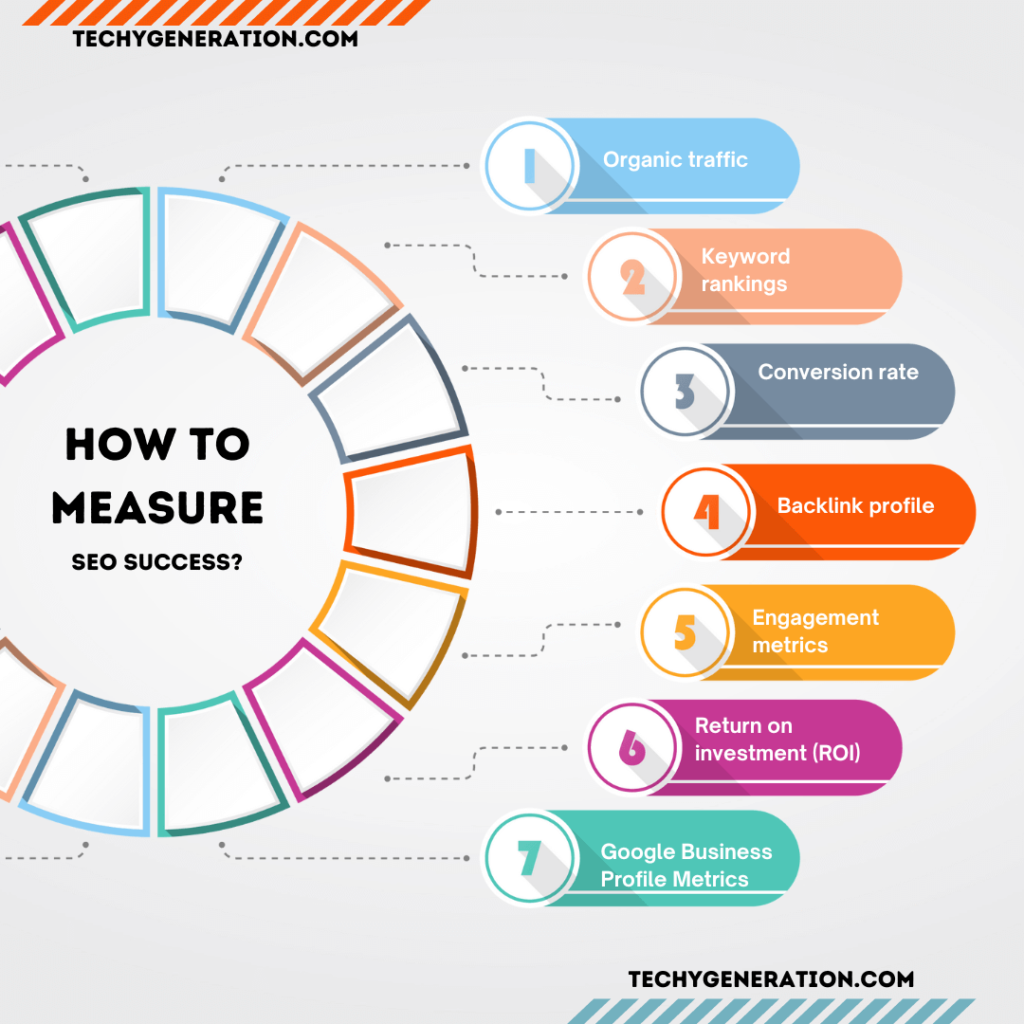
To measure SEO success, you can track various metrics and analyze the following:
- Organic traffic: Monitor the number of visitors coming to your website through organic search results.
- Keyword rankings: Keep an eye on how your target keywords are ranking in search engine results over time.
- Conversion rate: Analyze how many website visitors are converting into customers or taking desired actions.
- Backlink profile: Assess the quality and quantity of backlinks pointing to your website.
- Engagement metrics: Look at metrics like bounce rate, time on page, and page views per session to understand user engagement.
- Return on investment (ROI): Calculate the revenue or business impact generated through organic traffic and conversions.
By regularly monitoring these metrics, you can evaluate the effectiveness of your SEO efforts and make informed decisions to optimize your website further.

